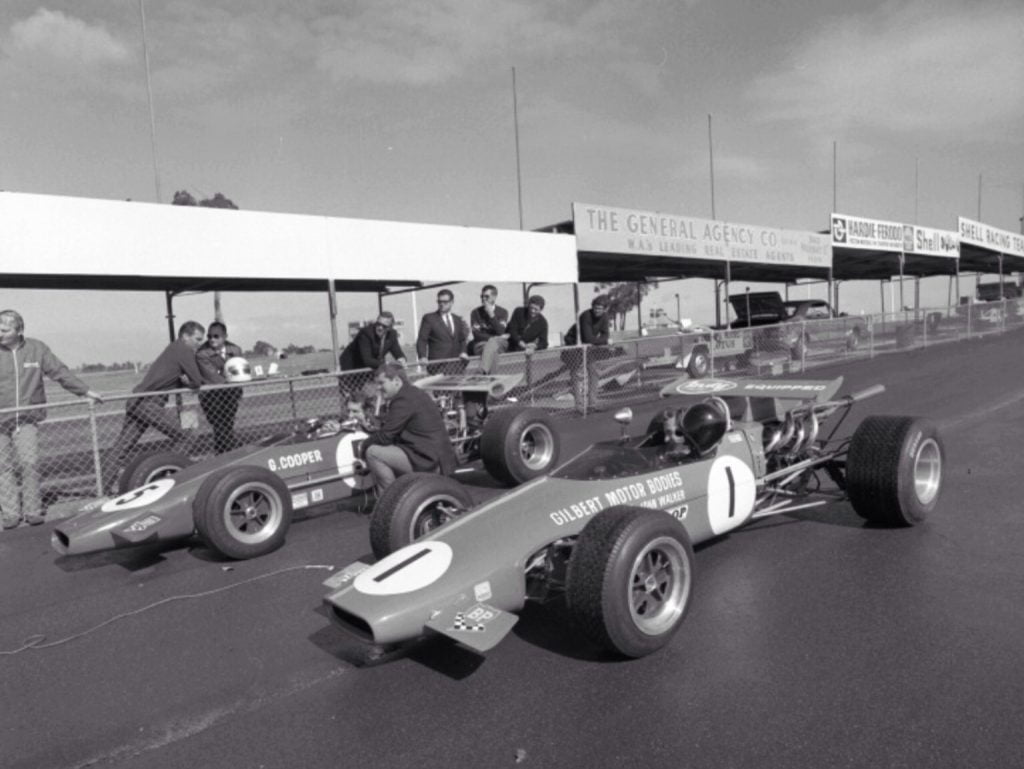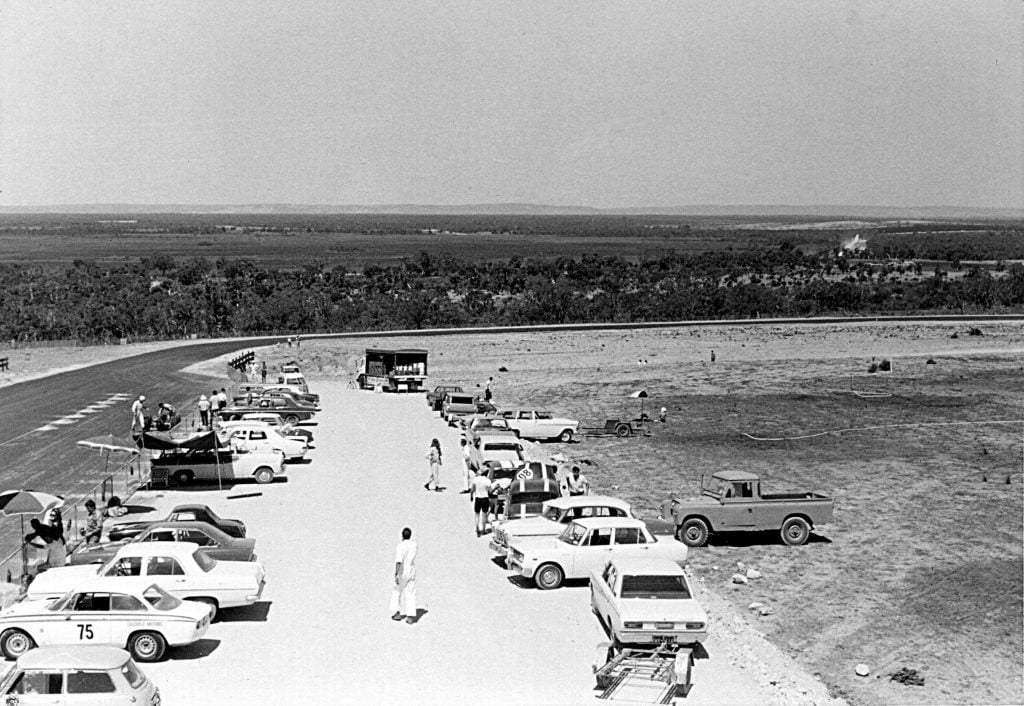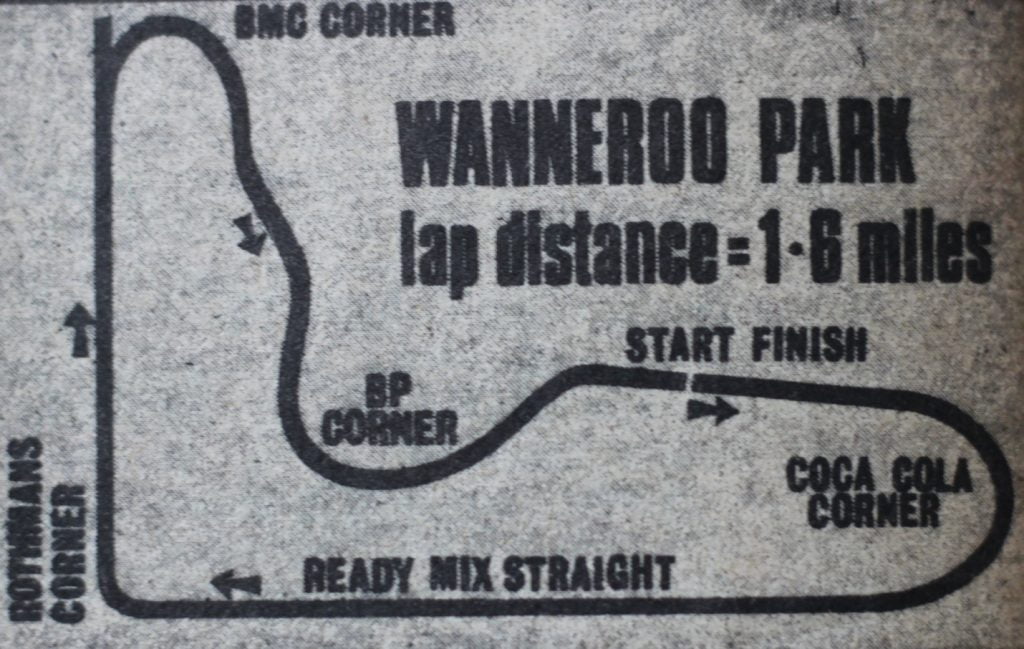
Cars start to line up outside the original Pits which was located on the straight between the turns currently known as Turn 5 and Turn 6.


Edited by John Hurney
At a glance – The WASCC is the longest established motor racing Club in Australia with a proud history of organizing circuit races and other events for more than 80 years. Here are some significant dates in the club’s history.
1929 Club formed and first Hillclimb event run.
1931 WASCC incorporated.
1936 WASCC organises first true road race in WA on Albany street circuit.
1939 Club member Alan Tomlinson makes history by becoming the only WA driver thus far to win Australian Grand Prix, at Lobethal (SA) in his MG.
1940 Club runs only road race ever in metropolitan Perth, the “Patriotic Grand Prix “ in Applecross to raise funds for war charities.
1946 WASCC runs first post WW2 road racing in Australia at Caversham airbase in Middle Swan.
1951 WASCC conducts Australian Grand Prix (AGP) on road course in Narrogin, won by Warwick Pratley (Ford Special).
1953 Obtains long term lease on Caversham circuit property.
1953 WASCC supports the establishment of the Confederation of Australian Motorsport (CAMS) – Australia’s peak motorsport sanction body.
1955 Club runs the first 6 hour endurance race at Caversham – won by Sydney Anderson and Sid Taylor’s Austin Healey. For many years the 6 Hour remains the only endurance race run in Australia.
1957 AGP conducted at Caversham, won by Lex Davison (Ferrari).
1962 second AGP run at Caversham won by Bruce McLaren (Cooper).
1965 last WA public road circuit race event run in Geraldton.
1968 Final Caversham meeting held, work commences Building Wanneroo Park Raceway – currently known as Wanneroo Raceway.
1969 Wanneroo Park Raceway opens.
1973 first Australian Touring Car Championship event in WA won by Alan Moffat (Falcon GTHO).
1979 final purely domestic AGP run at Wanneroo won by Johnny Walker (Lola).
1992 1.7 km Short Circuit link built, enabling racing at night under lights.
1993 Mark Skaife wins first V8 Supercar race run in WA.
2000 WASCC member Garth Tander becomes first WA driver to win Bathurst 1,000, wins again in 2009 & 2011
2005 Perth’s only Hillclimb course, Jack’s Hill opened on WASCC’s Wanneroo property.
2007 WASCC member Garth Tander becomes first WA driver to win the V8 Supercar Championship.
2011 New infield pit/garage area built specifically for V8 Supercars along with new Race Control building.
2014 WASCC member Daniel Ricciardo becomes first WA driver to win a round of the World Driver’s Championship by winning the Canadian Grand Prix. Subsequently wins again in Hungary and Belgium and finished 2014 3rd in the World Drivers Championship.
The W.A. Sporting Car Club is the longest established motor sport Club in the State and the senior Club promoting motor racing in Australia.
The history of the Club can be traced back to 1927 and the WASCC has been involved in the administration of WA motor sport ever since.
As far as we can tell, this Club has conducted virtually all motor racing and associated competitions run in the State. Handed down as some of the folk lore of the Club are stories of Hill Climbs being run up Mount Street in the heart of Perth in the 1920s.
One of the first “circuits” used was a high speed track on a salt lake (Lake Perkolilli) near Kalgoorlie, where speeds in excess of 160kph were being reached even in the 1920s.
As interest in the sport grew, competitions – both race meetings and hillclimbs – began being staged on closed public roads. Generally races took place in country towns.
Throughout the 1930s these events flourished, with probably the highlight of the year being the annual Albany Grand Prix. The only such event to be held in the Metropolitan area was the 1940 Patriotic Grand Prix run on the streets of Applecross, which was the last event run by the club before wartime priorities precluded further racing.
After the end of WW2 in 1945 the WASCC rapidly re-organised and ran the Victory Grand Prix on a makeshift circuit at the RAAF stand-by airbase at Caversham in Middle Swan. Attended by 60,000 people on April 7th 1946 this was probably the first race meeting run outside of Western Europe after war’s end and certainly the first racing run in Australia after peace was declared.
Until the 1960s the Club conducted races on street circuits in various country towns including Albany, Goomalling, Collie, Dunsborough, Bunbury, Northam and Narrogin as well as on various circuit combinations at Caversham. In 1956 the Club obtained a lease for Caversham, which was rapidly converted into a permanent track, using the sealed track connecting the aircraft parking bays as part of the circuit.
Racing on the country town circuits still carried on, but the bulk of the Club’s activities were at Caversham. However, as the performance of cars increased, the road circuits became less viable for safety reasons. The final road circuit meeting was held at Geraldton in 1966.
The Club had the honour of conducting the Australian Grand Prix at Caversham in 1962, in conjunction with the British Commonwealth Empire Games. A great deal of money was spent on the circuit to bring it up to the required standard. Star drivers such as Jack Brabham, Bruce McLaren and Bob Stillwell took part in the fastest Grand Prix cars of the time. The meeting itself was a great success as far as the organisation and racing were concerned. But the gate income was far less than had been budgeted, and the Club ended the meeting heavily in debt to local businessmen.
Faced with the choice of voluntary liquidation, or paying off the debt, the Club chose unanimously to follow the latter course. By the end of 1967 the debt had been paid in full.
Another challenge then arose when the Club was informed that the Commonwealth would resume the Caversham land for in 1968. This put the Club in a very difficult position, since they had to find land and build a circuit within the incredible short space of twelve months or less. Fortunately the Caversham area was to be handed over to the Department of the Army and the then Vice President, Max McCrackan had served with the Commander Western Command. Thus an assurance was given that the Club would be able to use the Caversham Circuit until the end of 1968 and salvage anything it could from the circuit following the close of the racing season.
Then the search began for a suitable area of land on which to build a racing circuit. At least 200 acres were needed. The assistance of the then Deputy Premier and Minister for Industrial Development, Hon. H. E. Graham was sought. He had been a member of the Club and an enthusiastic supporter for some time and he took endless pains to assist the Club in their project.
Soon, a tract of land was found in the Wanneroo area. The Shire of Wanneroo agreed to the land being declared an “A” Class Reserve, and it was with great jubilation that the Club received a letter from Hon. H. E. Graham advising that the Governor’s signature would be affixed to the document turning “Reserved No. 10866 from ‘quarrying’ to ‘recreation’ (motor sport)”. Planning then proceeded apace!
The circuit was designed by Max McCrackan after seeking input from club members and looking at other circuits, and he subsequently spent some eight months supervising and keeping the various contractors up to the time schedule.
Most of the money required was borrowed. A loan was raised through the Shire of Wanneroo and various Companies and Firms contributed towards the cost in return for advertising rights. Meanwhile the Club was carrying on racing at Caversham.
In October 1968 the last race meeting was run at the Caversham circuit amidst scenes of much nostalgia – Touring Car legend Norm Beechey won the last race in his 327 Monaro.
Work on the Wanneroo site then hit top gear, with club volunteers working alongside the contractors and, despite some dire predictions, the new track rapidly took shape from the virgin bush.
In March 1969 the first race meeting was conducted at Wanneroo Park. The “Speed Classic” meeting on March 2nd was not heavily advertised, as the facilities were not quite ready for a capacity crowd. Consequently, it was quite embarrassing when the crowd poured in, accompanied by clouds of dust, overflowed the parking areas and caused the ticket collectors to quit their posts after only 4,600 people had been through. The crowd has been estimated at over 6,000.
After a few initial teething troubles racing thrived at Wanneroo throughout the balance of the 1960s and well into the 1970s. For many years the premier event was the annual 6 hour Le Mans race for Sedans and Sports Cars and, when interest in this gruelling event faded, Production Car racing took over as the big drawcard.
In 1979 the Australian Grand Prix was held at Wanneroo and this event also marked the opening of the newly relocated pit/paddock area on the western side of the circuit. The AGP was a thrilling event which began with a spectacular first turn accident between Larry Perkins and Alf Costanzo and saw South Australian Johnny Walker come back through the field to win after a pitstop to remove a trailing exhaust component.
Throughout the 1980s the strength of Touring Car racing continued to grow nationally and this was reflected in WA where massive crowds attended the annual Perth round of the V8 Supercar Series.
At the Club’s Annual General Meeting in 1992, then Club President, John Hurney, announced that the Club would begin construction of the often proposed short circuit. This consisted of a link from the current Turn 5 to the west of the back straight to form a new 1.7 km circuit. Substantial support was gained from long term sponsor Alf Barbagallo to enable the construction of the short circuit and it was announced that the Circuit would be known as Barbagallo Raceway Wanneroo.
The first race meeting was held on the short circuit on February 20, 1993. The new circuit opened up the possibility of night racing and truck racing as well as making the facility much more attractive for the wide variety circuit users. The first truck race on the short circuit was held in its inaugural year and the advent of night racing, which has proved to be a popular choice of entertainment for spectators, began in February 1995.
n 2004 the task of resurfacing the entire 2.41km long circuit was undertaken. After much research by Committee member Sean Supanz, an appropriate asphalt mix was decided upon and contractors Asphalt Surfaces undertook the work. This work cost $500,000. The result was a resounding success, with almost every lap record broken in the first months of the 2004 season.
For 2005 the club addressed the long recognised need for a permanent Hillclimb course in WA with the building of an 880m on the club’s leasehold property adjacent to the Raceway. Named Jack’s Hill after the late Jack Nelson – who bequeathed the club significant funds which assisted in construction costs – the course was opened in September 2005 by CAMS CEO Dr Rob Nethercote.
In January of 2019, the Club again resurfaced the entire Main Circuit. These works also included the addition of a ‘Bus Stop Chicane” at Turn 3, which allowed for the return of Motorcycle activity to the Raceway following a hiatus since mid 2016.
Today the WASCC promotes eight to ten race meetings per year, with the highlight of each season being the WA Round of the V8 Supercar Series. This is undoubtedly one of the biggest sporting events in Western Australia, with around fifty thousand spectator’s trackside over the 3 days and a national live television audience in the millions.
The club also conducts a number of Drift Battles, Super Sprints, Hillclimbs plus a Member’s Tuning Day at the circuit two or three times most months. The WASCC runs more competition events than any other CAMS affiliated club in Australia. Furthermore, the track is used virtually every day of the week by clubs wishing to conduct events, competitors using it for private testing, commercial organisations staging vehicle promotions, schools for advanced driver and rider training, and the Police Department to instruct their new recruits.
The WA Sporting Car Club is a not for profit organisation, which requires all funds generated by club activities to be reinvested in club activities and facilities. Its main aim is to both enhance and continue its role as the leading promoter and organiser of CAMS sanctioned Motorsport in Western Australia.
1966 – WASCC was advised that the lease on its existing facility at Caversham would not be renewed by the Department of Defence.
In mid-1968 the current site was designated by Wanneroo Council/WA State Govt/WASCC for the use of Motor Racing.
By late 1968 the site clearing was completed as the area was virgin & re-growth bush – detail work commenced by WASCC volunteers, who largely built the circuit.
In January 1969, the asphalt was laid with the first race meeting conducted in February that year. The circuit was useable but the facilities were far from finished. The Pit/Paddock area was then located at the top of the hill on the infield adjacent turn 5.
All this was paid for by the WASCC and the Club’s loyal sponsors. As funds ran low close to the designated opening day, repayable debentures were issued to Club members and supporters to finance last minute works. The Club had a bank loan kindly guaranteed by the Wanneroo Council – fully repaid. The WASCC also acknowledges the tremendous support of the Wanneroo Council with the loan of machinery and advice at that time.
1969 to 1974 – The Raceway was largely completed with the expenditure of many thousands of dollars and thousands of man hours contributed by WASCC members. The spectator areas and required extra toilet blocks were built, infield/outfield converted from limestone rock strewn desert to relatively manicured areas as well as other works.
1974 – The start/finish line was moved to its current location and the infield tower built was built with sponsors funds.
1979 – Pit/Paddock area was moved to its current position west of the current start line. All works were paid for by WASCC and Club sponsors; most labour was supplied by WASCC volunteers over a period of 4 months.
1979 to 1985 – Many more improvements were made including much larger spectator banks, reticulation, expansion of Race Control & Media, asphalting of Paddock roads to name a few. All works were paid for by the WASCC and Club sponsors with most labour supplied by WASCC volunteers.
1985 to 1987 – the circuit was resurfaced for the first time and completed done in several tranches. The first pit garages were also built – all paid for by WASCC members.
1991 – Short 1.7km track built and track lighting installed – paid for by major sponsor Spices Catering & WASCC
1991 to 2004 – Safety improvements such as flush kerbs, trackside barriers, protection for officials plus another 60 or so pit garages all paid for by the WASCC.
2005 – Second track resurface completed with 1/3 of the cost covered by grant and 2/3 by WASCC.
2006 to 2010 – Further safety improvements made including spectator debris fences, CCTV system and Jack’s Hill hill climb course all paid for by the WASCC.
2011 – The current infield pit area & race control/admin building was constructed to service the Supercar event and its contract with the State government under a Financial Assistance Agreement with the State Govt to which the WASCC contributed over $2.5m in cash & kind.
2012 to 2016 – 30 new garages, over 400m of new trackside wall and new kerbing all paid for by WASCC.
2019 – third track resurface completed as well as insertion of ‘bus-stop’ at turn 3 for MA sanctioned motorcycle events; significant resurface and drainage work completed in paddock area. All works paid for by WASCC.
All told, WASCC has spent approximately M$150 in cash and kind building, developing and maintaining the raceway since 1968.